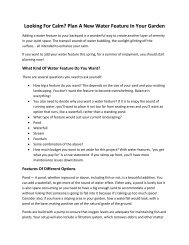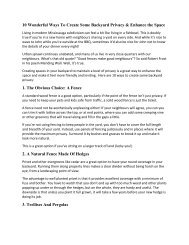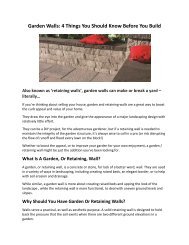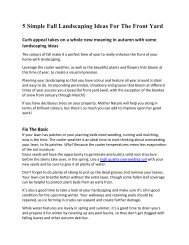Garden Walls: 4 Things You Should Know Before You Build
Make your Retaining walls more beautiful with the help of Toemar. We will use concrete wall products for that, which will give a different look to your wall and also that will have a feel of natural stone.
Make your Retaining walls more beautiful with the help of Toemar. We will use concrete wall products for that, which will give a different look to your wall and also that will have a feel of natural stone.
Create successful ePaper yourself
Turn your PDF publications into a flip-book with our unique Google optimized e-Paper software.
<strong>Garden</strong> <strong>Walls</strong>: 4 <strong>Things</strong> <strong>You</strong> <strong>Should</strong> <strong>Know</strong><br />
<strong>Before</strong> <strong>You</strong> <strong>Build</strong><br />
Also known as ‘retaining walls’, garden walls can make or break a yard –<br />
literally…<br />
If you’re thinking about selling your house, garden and retaining walls are a great way to boost<br />
the curb appeal and value of your home.<br />
They draw the eye into the garden and give the appearance of a major landscaping design with<br />
relatively little effort.<br />
They can be a DIY project, for the adventurous gardener, but if a retaining wall is needed to<br />
maintain the integrity of the garden structure, it’s always wise to call in a pro (or risk disrupting<br />
the flow of runoff and flood every lawn on the block!)<br />
Whether to boost the appeal, or to improve your garden for your own enjoyment, a garden /<br />
retaining wall might be just the addition you’ve been looking for.<br />
What Is A <strong>Garden</strong>, Or Retaining, Wall?<br />
A garden, or retaining wall, is a concrete or stone, for lack of a better word, wall. They are used<br />
in a variety of ways in landscaping, including creating raised beds, an elegant border, or to help<br />
with soil erosion and drainage.<br />
While similar, a garden wall is more about creating raised beds and upping the look of the<br />
landscape , while the retaining wall is more functional, to deal with uneven ground levels and<br />
slopes.<br />
Why <strong>Should</strong> <strong>You</strong> Have <strong>Garden</strong> Or Retaining <strong>Walls</strong>?<br />
<strong>Walls</strong> serve a practical, as well as aesthetic purpose. A solid retaining wall is designed to hold<br />
back the pressure that the soil exerts when there are two different ground elevations in a garden.<br />
A slope might not be what you want in the garden, so the wall acts to break up the two<br />
elevations. The stability of the soil and more elevated portion of the garden is ensured by the<br />
solid stone or concrete wall, which takes the bulk of the pressure being exerted by the soil.<br />
<strong>Garden</strong> walls are more about design: they typically aren’t as tall and are used more to create<br />
divided garden areas and beds, rather than to deal with slopes or elevations. They can be created<br />
in curved designs, which are very elegant and can enhance your flower beds and other divided<br />
garden areas immeasurably.<br />
Materials Used In <strong>Garden</strong> <strong>Walls</strong>
Whether you opt for stone or concrete, most walls products are mortarless these days, which<br />
makes garden walls a project that the DIY landscape gardener can undertake (with caution.)<br />
<strong>You</strong> can also opt for a combination of concrete and stone, such as where you use natural stone<br />
for steps or for the caps / coping; you or your hardscaper can create an elegant design that will<br />
last for years.<br />
Concrete forming technology has resulted in concrete wall products that have the look and feel<br />
of natural stone, available in a range of textures and colours.<br />
Concrete is lighter than natural stone, making it possible to build a wall without the extensive use<br />
of machinery, though it does require a level base, which might take some effort to dig down to<br />
create, to prevent the wall from shifting down the road.<br />
Concrete wall systems are designed for easy tongue-and-groove interlocking installation and the<br />
new designs allow you to create curves that are still smooth and consistent.<br />
One of the biggest pluses to concrete, particularly if this your first attempt at building a wall, is<br />
that is relatively inexpensive, compared to natural stone.<br />
Those points made, natural stone has a beauty to it that is unmatched in other products.<br />
The stones are different shapes and sizes, so they take more creativity to fit together tightly to<br />
build the optimal wall, but the result is gorgeous. Natural stone is stronger—and consequently<br />
heavier to work with—and requires less effort during the leveling process, as most natural stones<br />
aren’t perfectly level to begin with.<br />
<strong>You</strong> may need some machinery to bring in natural stone and it is much harder to create a curved,<br />
consistent look. But when a natural stone wall is put together, with flair and design, it’s a sight to<br />
behold!<br />
<strong>Should</strong> <strong>You</strong> DIY <strong>You</strong>r Wall?<br />
The short answer is: Probably not.<br />
<strong>Build</strong>ing a retaining wall to deal with unequal ground levels without the help of a professional<br />
CAN be risky. <strong>You</strong> want to be sure that you aren’t interfering with run-off patterns. Drainage<br />
that isn’t planned properly could end up seeping into your—or your neighbour’s—basement,<br />
among other risks.<br />
Like what? Foundation erosion, drowning plants and trees, wood rot on decks and other garden<br />
features, pests and so on!<br />
<strong>Build</strong>ing a garden wall, which is far more about creating a design that you want for your yard, is<br />
much simpler and can be done with a little design help from your local garden centre. With it,
you will soon have a new focal point in your yard and a new area to grow flowers, plants and<br />
trees.<br />
Concrete or stone, DIY or professionally installed, consider garden or retaining walls when<br />
you’re planning your landscaping changes: they can add a real dimension of visual interest to<br />
your yard, helping it to make it an oasis for you and your family to enjoy!<br />
http://www.toemar.ca/


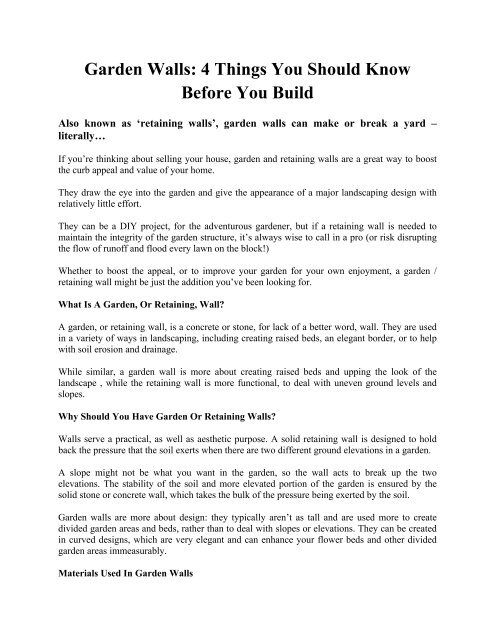



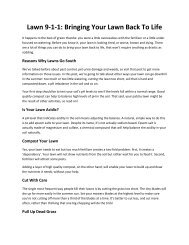


![What’s Hot In Backyard Design in 2018 [6 Tips to an Amazing Yard]](https://img.yumpu.com/60436469/1/190x245/whats-hot-in-backyard-design-in-2018-6-tips-to-an-amazing-yard.jpg?quality=85)
